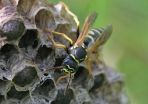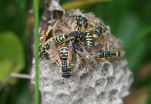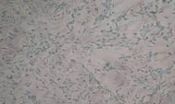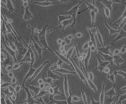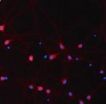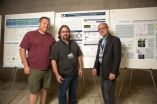(Press-News.org) Swiss scientists have discovered a new species of aculeate wasp, not hidden somewhere in a jungle on a remote continent, but in Central Europe, in a swampy area just a few kilometers from Zurich. The new species named "Polistes helveticus", or the Swiss paper wasp, was described in the open access journal ZooKeys.
Paradoxically, this species has been long known in Central Europe but was confused for decades with a closely related species native to southern Europe. Only after the latter expanded its range to northern Switzerland, possibly following climate change, was the confusion noticed.
Six years ago, the Swiss entomologist Rainer Neumeyer discovered a population of paper wasps in wetlands close to Zurich. He thought that he had found P. bischoffi, a well-known species in Switzerland. But at the same location he found another species which, although quite similar to the first, was unusual and could not be identified with certainty.
Neumeyer contacted scientists Gaston-Denis Guex from the University of Zurich, Hannes Baur from the Natural History Museum of Bern, and Christophe Praz from the University of Neuchatel. Together, the scientists used genetic and morphometric analyses to confirm the coexistence of two distinct species at the locality close to Zurich: a northern taxon, already well known from Central Europe, and a little known taxon mostly distributed in southern Europe.
After reviewing the information on the type material, the scientists came to the conclusion that the southern species was P. bischoffi, described 80 years ago from Sardinia. The northern species was given the name P. helveticus.
The southern species was not present in northern Switzerland until recently. The confusion was only revealed after P. bischoffi expanded its distribution northwards, possibly following climate change.
INFORMATION:
Original Source:
Neumeyer R, Baur H, Guex G-D, Praz C (2014) A new species of the paper wasp genus Polistes (Hymenoptera, Vespidae, Polistinae) in Europe revealed by morphometrics and molecular analyses. ZooKeys 400: 67–118. doi: 10.3897/zookeys.400.6611
The Swiss paper wasp, a new species of social Hymenoptera in Central Europe
2014-05-07
ELSE PRESS RELEASES FROM THIS DATE:
TAG-1 induces apoptosisrelated gene expression without triggering glioma apoptosis
2014-05-07
A recent study reported by Haigang Chang and co-workers from the First Affiliated Hospital of Xinxiang Medical University in China verified the effects of transient axonal glycoprotein-1 (TAG-1) on cell viability and p53, epidermal growth factor receptor (EGFR), and amyloid precursor protein (APP) intracellular C-terminal domain (AICD) expression in U251 glioma cells. Their pilot study showed that the signaling pathways induced by TAG-1, TAG-1/APP/AICD/p53 and TAG-1/APP/AICD/EGFR, did not inhibit glioma development by inhibiting cell proliferation or by inducing apoptosis. ...
Shuganjieyu capsule increases neurotrophic factor expression in a rat model of depression
2014-05-07
Shuganjieyu capsule has been approved for clinical treatment by the State Food and Drug Administration of China since 2008. In the clinic, Shuganjieyu capsule is often used to treat mild to moderate depression. Prof. Jingping Zhao and team from the Second Xiangya Hospital, Central South University in China conducted a study to examine the effect of Shuganjieyu capsule on behavioral changes in a rat model of depression. They focused on the underlying mechanisms of Shuganjieyu capsule by examining brain-derived neurotrophic factor and phosphorylated cyclic adenosine monophosphate ...
Psilocybin inhibits the processing of negative emotions in the brain
2014-05-07
Emotions like fear, anger, sadness, and joy enable people to adjust to their environment and react flexibly to stress and strain and are vital for cognitive processes, physiological reactions, and social behaviour. The processing of emotions is closely linked to structures in the brain, i.e. to what is known as the limbic system. Within this system the amygdala plays a central role – above all it processes negative emotions like anxiety and fear. If the activity of the amygdala becomes unbalanced, depression and anxiety disorders may develop.
Researchers at the Psychiatric ...
rAAV/ABAD-DP-6His attenuates oxidative stress induced injury of PC12 cells
2014-05-07
The effects of Amyloid beta (Aβ)-Aβ-binding alcohol dehydrogenase (ABAD) may exacerbate Alzheimer's disease pathology. Therefore, blocking Aβ-ABAD-mediate effects with ABAD decoy peptide (ABAD-DP) may be a potential therapeutic strategy for Alzheimer's disease. Dr. Jiang Wu and team from the First Hospital of Jilin University in China successfully constructed a recombinant adenovirus constitutively secreting and expressing Aβ-ABAD decoy peptide (rAAV/ABAD-DP-6His). Their results showed that rAAV/ABAD-DP-6His increased superoxide dismutase activity in ...
Starting signal for antiviral defense
2014-05-07
In human cells, DNA occurs only in the cell nucleus as the carrier of genetic information. In order to protect it, specialized proteins regularly scan the individual strands for defects, and repair them. One example of this is the protein Rad50, a DNA sensor that binds to DNA and detects defective sites. A team of scientists headed by Prof. Jürgen Ruland of the TUM together with colleagues from the LMU have now discovered another important task performed by Rad50.
There is normally no DNA in the cytoplasm surrounding the cell nucleus. However, if any does turn up there, ...
Geniposide protects hippocampal neurons via the non-classical estrogen signaling pathway
2014-05-07
Amyloid-β (Aβ) plaques and neurofibrillary tangles are the main pathological hallmarks of Alzheimer's disease, as well as the loss of neurons and synapses. recent reports have shown that estrogen exerts neuroprotective effects. However, large clinical trials in postmenopausal women indicated adverse side-effects of estrogens, such as increased incidence of breast cancer and metrocarcinoma, thereby preventing clinical use of estrogen. Tongluojiunao (TLJN) is an herbal medicine consisting of two main components, geniposide and ginsenoside Rg1. Prof. Qian Hua and ...
Discovery offers new possibilities for clean energy research
2014-05-07
University of Houston physicists have discovered a new thermoelectric material offering high performance at temperatures ranging from room temperature up to 300 degrees Celsius, or about 573 degrees Fahrenheit.
"This new material is better than the traditional material, Bismuth telluride, and can be used for waste heat conversion into electricity much more efficiently," said Zhifeng Ren, M.D. Anderson Chair professor of physics at UH and the lead author of a paper describing the discovery, published online by Nano Energy.
Ren, who is also principal investigator at the ...
Ability to isolate and grow breast tissue stem cells could speed cancer research
2014-05-07
LA JOLLA—By carefully controlling the levels of two proteins, researchers at the Salk Institute have discovered how to keep mammary stem cells—those that can form breast tissue—alive and functioning in the lab. The new ability to propagate mammary stem cells is allowing them to study both breast development and the formation of breast cancers.
"What we've shown is that we can take these cells out of a mouse and study them and regulate them in the laboratory by providing them with a specific factor," says Peter C. Gray, a staff scientist in Salk's Clayton Foundation ...
Today's offenders are tomorrow's victims in gangs
2014-05-07
HUNTSVILLE, TX (5/7/14) -- Gang members are twice as likely to become both a victim and an offender of a crime than non-gang members, as single acts of violence often lead to retribution between gangs as a whole, according to a new study.
"In other words, gang members are not distinctly offenders or victims; instead, gang membership is a common source of both forms of violence," said David Pyrooz, an assistant professor at Sam Houston State University, College of Criminal Justice and principal author of the study. "Today's criminal offender is tomorrow's victim, and today's ...
Arctic study sheds light on tree-ring divergence problem
2014-05-07
SAN FRANCISCO -- Changes in tree-ring density in the Arctic may be evidence of changes in light intensity during the trees' growth, according to a new study by San Francisco State University researcher Alexander Stine.
The finding has direct implications for the tree-ring "divergence problem," a phenomenon that has received considerable media attention but has been widely misinterpreted, said Stine, an assistant professor of Earth & climate sciences.
Tree rings consist of a low density ring, which forms early in the growing season, and a high density ring that forms ...
